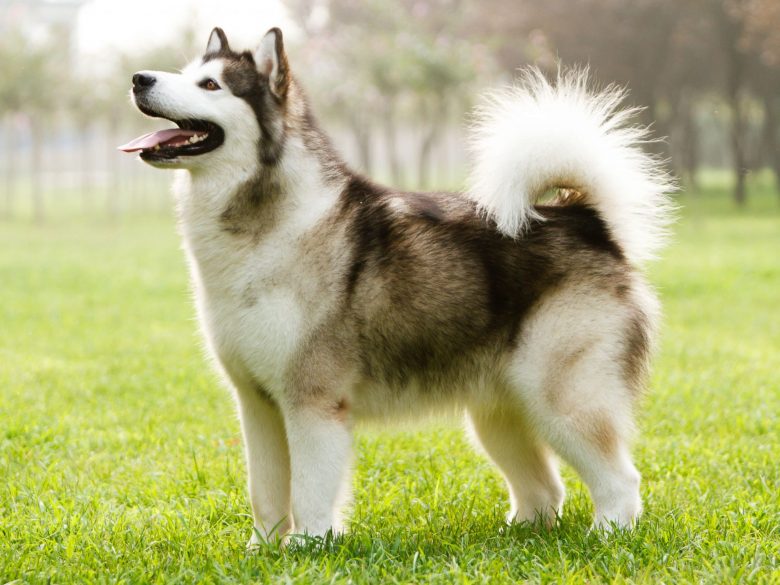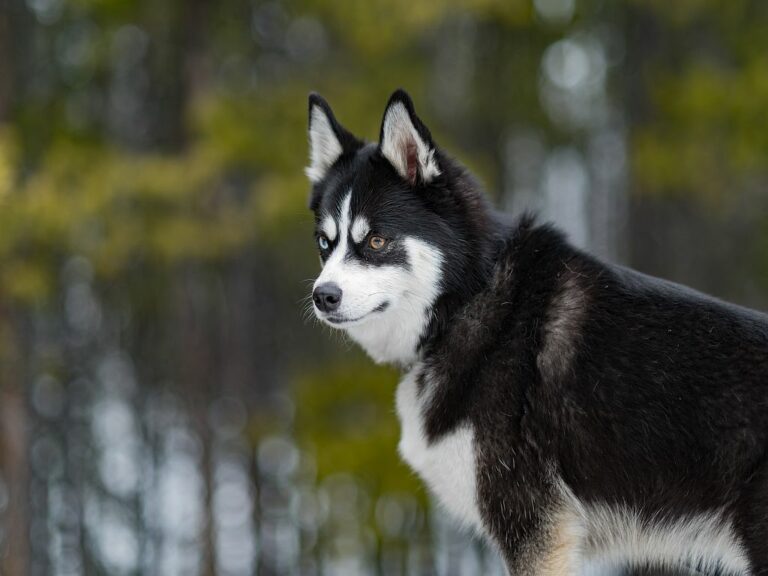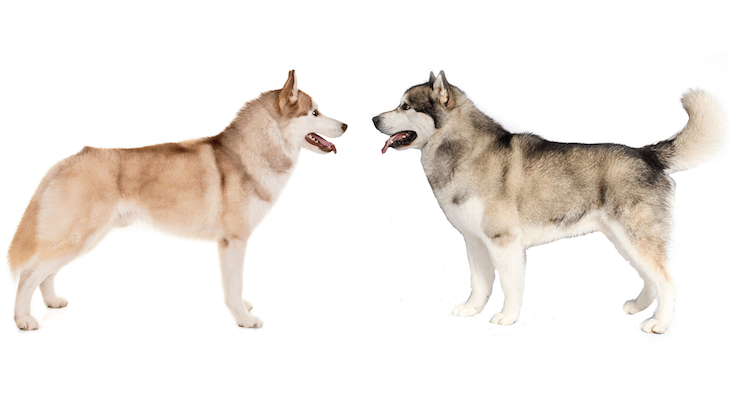Consider which breed is best for you if you have to choose between two (husky or malamute)? Think about why you want these dogs to begin with. It’s amazing how many people buy them just because they’re attractive. These dogs, however, are one-of-a-kind, and not everyone is pleased with them after receiving them. They are self-sufficient, active, and emotional dogs. Expect them to walk alongside you, give you a friendly smile, and hand you your slippers. This will simply not be the case. This is how these breeds would express themselves. They necessitate physical exercise. If there aren’t any, the dogs will start digging, howling, fleeing, and destroying property, among other things. If you have a child or other family members who are constantly wanting to cuddle and play with the dog, be aware that huskies and malamutes will growl to express their displeasure. Huskies are more likely to leave with a stranger than Malamutes, who are more attached to their owners. They are far more self-sufficient and rebellious. Malamutes are known for their stubbornness and aggression toward other dogs and people. At the same time, they are easier to manage and live with because they are calmer. Both breeds necessitate a lot of physical exertion. In order to channel their energy properly, you should engage in some sports with them.
Table of Contents
What is a Malamute?

The overall appearance of an Alaskan Malamute is strikingly similar to that of a wolf. Malamutes are first and foremost athletes, with a powerful but not bulky frame that is large and powerful without being heavy or thickset. The thick double coat is made up of a dense undercoat that can reach 5 cm in length and coarse outer hairs that are much longer on the neck and tail than on the trunk.
What is a Husky?

A husky is a sled dog in the polar regions. Huskies are known for their fast pulling style, which sets them apart from other dog breeds. They are a constantly changing crossbreed of the fastest dogs when used as sled dogs (the Alaskan Malamute, on the other hand, pulled heavier loads at a slower speed). Humans use huskies in sled dog races. A number of companies have promoted tourist treks with dog sleds for adventure travelers in snowy areas. Huskies are also kept as pets, and rescue organizations help retired racing and adventure-trekking dogs find new homes.
Where do Malamutes come from?
You’ve probably seen a few Malamutes around town if you like big dogs. These beautiful dogs are very distinctive and well-liked in colder climates. The breed is indigenous to Alaska and has been around for over 2000 years. These dogs are very popular in our area (Montréal), where the Alaskan Malamute Eskimo tribe used them as sled dogs. They make great companion dogs, but they’re also used in arctic races as sled dogs. However, there are a few things to keep in mind. Some of the most frequently asked questions about them are listed below.
Where do Huskies come from?
At some point in prehistory, the Chukchi people, an indigenous Russian tribe, developed Siberian Huskies. The breed’s ancestors were most likely used to hunt, and at some point, they began to pull the sleds of the nomadic people with whom they shared the land, allowing them to travel farther and faster. They were bred to be not only energetic and tenacious, but also companionable, and they played an important role in the Chukchi people’s daily lives. These tenacious dogs were brought to Alaska in the early 1900s to compete in the All Alaska Sweepstakes race, and they won. Before the United States entered World War I, several teams comprised of this breed won annual competitions. Long after the races had been canceled, these sled dogs made their most well-known contribution to American history in 1925. In the winter of that year, a diphtheria epidemic struck the small town of Nome, putting the entire region’s population of around 10,000 people at risk. Twenty sled drivers and over a hundred dogs, the majority of whom were Siberian Huskies, made the 658-mile journey to Nulato, Alaska, to pick up the serum and bring it back to Nome. In appalling weather, a journey that should have taken twenty-five days was completed in just under six. Drivers would sometimes run alongside the sleds to keep warm while transporting the serum to Nome, and at least four dogs died in the process. On the final leg of the journey, Gunnar Kaasen led the team, but it was the dogs who delivered the serum because the weather prevented him from seeing even the two dogs closest to the sled. Balto, a mixed breed of Siberian Husky descent who led the final leg of the journey with great skill, received the most public acclaim, but all of the dogs who ran tirelessly in this race for survival should be remembered. Only a few years later, in 1930, the American Kennel Club recognized this brave breed.
Malamute vs Husky: Size
The Alaskan malamute’s bone structure is much larger than that of the Siberian husky. According to the breed standard, the “desirable” size for a male malamute at maturity is 25 inches tall at the shoulder and weighs around 85 pounds. For a female, it stands 23 inches tall and weighs 75 pounds. Because this is a working breed, proportion, strength, and movement are more important than size.
Malamute Size
The difference in size between the Siberian Husky and the Alaskan Malamute can be used to tell them apart. This is the clearest distinction. Both dogs will, without a doubt, be described as large dogs. The Siberian Husky is capable of growing to be 24 inches tall. On average, the Alaskan Malamute stands about 25 inches tall. However, the weight difference is noticeable. The Alaskan Malamute will be much larger, weighing anywhere from 75 to 85 pounds depending on gender. The average weight of a Siberian Husky is 35 to 60 pounds, with the female being lighter than the male.
Husky Size
Male Huskys range in height from 21 to 24 inches (53 to 61 cm) and weigh 45 to 60 pounds. Females are slightly smaller and lighter than males, measuring 20-22 inches (51-56 cm) and weighing 35-50 lbs (16-23 kg).
Malamute vs Husky: Appearance
Some dog breeds are difficult to distinguish from one another. The Alaskan Malamute, Siberian Husky, and Alaskan Husky are all sled dogs bred to live in extreme cold, and they share some physical characteristics. Each breed, on the other hand, has its own distinct appearance and personality.
Malamute Appearance
The Alaskan Malamute, one of the oldest Arctic sled dogs, is a powerful and substantial dog with a deep chest and a strong, well-muscled body. The Malamute stands well over the pads, head erect and eyes alert, showing interest and curiosity, giving the appearance of much activity and a proud carriage. The head is broad and large. The ears become triangular and erect when they are alerted. The muzzle is thick, with only a slight narrowing from the root to the tip of the nose. The muzzle isn’t long or pointed, but it’s not short either. To protect the wooly undercoat, the coat is thick, with a long, coarse guard coat. Malamutes are available in a wide range of colors. Face markings are a distinguishing feature. The face is either completely white or marked with a bar and%2For mask, and the head is covered by a cap. The tail is thickly furred and resembles a waving plume when draped over the back. The Malamute must be a large, heavy-boned dog with sound legs, good feet, a deep chest, and powerful shoulders, as well as all of the other physical qualities needed for his job. Consistent, balanced, unwavering, and completely efficient gait is required. The Malamute is built for strength and endurance. The Alaskan Malamute is not a lone wolf, but rather a friendly, affectionate dog. He is a devoted and loyal companion, playful when invited, but generally dignified as he gets older. For a small child, Malamutes will gladly pull a wagon or sled. They are built to last and have strong legs. They have a lot of endurance due to their large bodies.
Husky Appearance
The Siberian Husky is a long-lived breed that has lived alongside humans for thousands of years. The Chukchis developed these canines in Russia to drag provisions behind them, allowing them to thrive in an inhospitable environment. This breed was created not only to transport property and people, but also to live peacefully and happily in the Chukchi household. As a result, the breed has developed into one that is friendly, enthusiastic, and has a lot of stamina. The thick double coat of the Siberian Husky, which keeps him warm in freezing temperatures, necessitates frequent grooming, though bathing is not as necessary. Despite their wolf-like appearance, this breed is frequently far too friendly to serve as a guard dog.
Malamute vs Husky: Temperament
The Husky and the Malamute aren’t known for their ferocity or aggression.
Malamute Temperament
The main difference in temperament between the two dogs is that the Siberian Husky is less possessive of its belongings. Despite the fact that they both have a strong prey drive, the Malamute is more likely to attack on occasion.
Husky Temperament
While both breeds make excellent pets, the husky has a better temperament than the malamute, though this is not always the case. Malamutes are friendly, but their Siberian counterparts are more dignified. He is his owner’s faithful companion. Although huskies are friendly, they require the constant presence of their owners or other dogs to feel secure. They are, without a doubt, herd animals. Huskies, on the other hand, are not watchdogs. To them, there is no such thing as a stranger. Huskies are hunter-gatherers who aren’t particularly fond of cats.
Malamute vs Husky: Exercise
The Alaskan malamute and Siberian husky are two dogs who are dedicated to the work for which they were bred. While both breeds have found their way into pet owners’ homes, their stature and exercise requirements are vastly different. Their care, cost, and lifespan can all play a role in deciding which one to adopt.
Malamute Exercise
Alaskan Malamutes make wonderful pets. These animals can make great pets for active families, but you should use extreme caution when petting them and never leave them alone with children unless they are supervised. Male and female Alaskan Malamutes have temperaments that are full of devotion, affection, and playfulness, making them excellent pets for both children and adults. This dog breed requires consistent training and exercise to avoid a variety of health issues.
Husky Exercise
Consider which breed is best for you if you have to choose between two (husky or malamute). Think about why you want these dogs to begin with. It’s amazing how many people buy them just because they’re attractive. These dogs, however, are one-of-a-kind, and not everyone is pleased with them after receiving them. They are self-sufficient, active, and emotional dogs. Expect them to walk alongside you, give you a friendly smile, and hand you your slippers. This will simply not be the case. This is how these breeds would express themselves. They necessitate physical exercise. If there aren’t any, the dogs will start digging, howling, fleeing, and destroying property, among other things. If you have a child or other family members who are constantly wanting to cuddle and play with the dog, be aware that huskies and malamutes will growl to express their displeasure. Huskies are more likely to leave with a stranger than Malamutes, who are more attached to their owners. &#x They are far more self-sufficient and rebellious. Malamutes are known for their stubbornness and aggression toward other dogs and people. At the same time, they are easier to manage and live with because they are calmer. Both breeds necessitate a lot of physical exertion. In order to channel their energy properly, you should engage in some sports with them.
Malamute vs Husky: Shedding
The malamute and husky are unrivaled when it comes to shedding. If you share a house with them, invest in a good vacuum cleaner. Siberian huskies have a reputation for being clean and odorless. With malamutes, this isn’t always the case. Both breeds require a good brushing a few times a week to reduce the amount of dog hair shed in the house, but the malamute requires more bathing than his husky counterpart.
Malamute Shedding
The dog requires daily exercise in the form of a good run or a leash walk because it can run long distances. The breed thrives in the cold, pulling a sledge or cart through the snow. It can be comfortable in cold or temperate climates, but it should be kept indoors during the summer. Meanwhile, an Alaskan Malamute’s coat should be brushed at least once a week, and more frequently during the shedding season.
Husky Shedding
Grooming is necessary for both dogs, regardless of how attractive they are. The husky’s coat is much easier to keep clean, requiring only weekly brushing and a bath once or twice a year. Malamutes are extremely high-maintenance dogs, and the only way to keep shedding and mats to a minimum is to brush them daily and bathe them every 6-8 weeks.
Malamute vs Husky: Grooming
The Alaskan Malamute and Siberian Husky are both groomed similarly. They should be groomed at least twice a week, if not more frequently, because they have a dense undercoat and a fluffy outer coat. When the weather begins to warm up in the spring, both the Husky and the Malamute shed heavily. To keep their coat manageable for you and your family, grooming will be required on a daily basis.
Malamute vs Husky: Price
Price is a consideration when deciding which product to buy in general, especially when choosing between Malamutes and Husky.
Malamute Price
On average, a Malamute costs around a thousand dollars. If you want one with superior lineage, you can expect to pay anywhere from $500 to $2000 or more, depending on the breed lines. A Siberian Husky is less expensive than a Malamute, with an average price of $725.
In Conclusion
When we were looking for our first Alaskan Malamute, we had no idea what the differences were. Now it appears to be self-evident. Checking Checking Checking But, as we wandered around Cobo Hall during the American Kennel Club dog show, trying to figure out which we preferred and what the differences were, we had no idea. I remember inquiring about the price difference between a purebred Alaskan Malamute and a purebred Siberian Husky, and being informed that it was $400 (back then). Malamutes were more expensive! However, I’ve discovered many differences since then and am glad we chose Malamutes over Siberians. While the hyperactivity of a Siberian husky may be beneficial to some people, I believe it would drive me insane. Many things are defined as different in breed standards, but the average person looking for a puppy is unlikely to have read the standard, nor would it help them make a decision. The standard doesn’t give you a good idea of what it’s like to live with a specific breed. I’ll try to explain the differences in layman’s terms, but the meme below pretty much sums it up.

